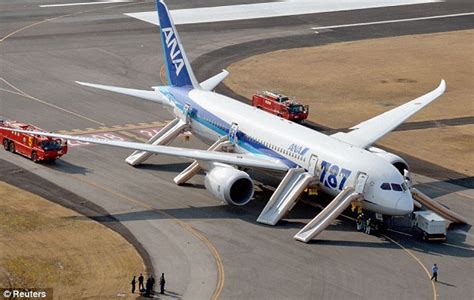
A Boeing 787 Dreamliner’s emergency power system may have automatically activated shortly before an Air India flight experienced a complete loss of engine power and critical flight control displays, according to a Wall Street Journal report. The incident, which occurred on a flight from Newark to New Delhi, has raised concerns about the aircraft’s electrical systems and prompted investigations by both Boeing and regulatory authorities.
The Wall Street Journal, citing people familiar with the preliminary findings, reported that the automatic deployment of the emergency Ram Air Turbine (RAT) is a central focus of the ongoing inquiry. The RAT is designed to provide essential power to the aircraft in the event of a complete engine failure, ensuring flight-critical systems remain operational. If the RAT deployed as a response to a failure of the main electrical power, it may indicate a more serious underlying problem with the electrical system, potentially affecting the plane’s ability to fly safely.
The incident, which took place earlier this year, involved an Air India Boeing 787 flying from Newark Liberty International Airport to Indira Gandhi International Airport in New Delhi. Pilots reported a total loss of power to both engines, accompanied by the simultaneous failure of multiple cockpit displays. The aircraft subsequently landed safely after the pilots were able to restore some electrical power.
The activation of the RAT is designed to act as a safety net in a dire situation; however, its deployment before a crash may be a new issue that must be understood and investigated further. This incident underscores the critical importance of redundant systems in modern aircraft design and the ongoing need for vigilance in maintaining and monitoring these complex systems.
Details of the Incident
The Air India flight, carrying hundreds of passengers, experienced a harrowing mid-air crisis when both engines unexpectedly lost power. Simultaneously, critical flight control displays in the cockpit went dark, leaving the pilots with severely limited situational awareness. According to the Wall Street Journal’s sources, the Ram Air Turbine (RAT) deployed automatically during this sequence of events. The RAT is a small turbine that extends from the aircraft’s fuselage and uses the oncoming airflow to generate electrical power, thus providing backup power to essential systems in the event of a complete engine or electrical failure.
The fact that the RAT deployed automatically suggests that the aircraft’s systems detected a catastrophic loss of primary electrical power, even before the engines completely shut down. This raises questions about whether the engine failures were a consequence of a broader electrical system malfunction, rather than independent engine problems.
Following the dual engine failure and display outages, the pilots managed to regain partial control of the aircraft’s electrical systems, enabling them to restart at least one engine and restore the critical displays. The pilots then navigated the aircraft to a safe landing at Indira Gandhi International Airport in New Delhi, averting a potential disaster.
Investigation and Regulatory Scrutiny
News of the incident has quickly drawn attention from aviation safety regulators and Boeing. Both parties have commenced investigations to determine the root cause of the power loss and the subsequent deployment of the RAT. The investigation aims to scrutinize every aspect of the aircraft’s electrical system, from the generators attached to the engines to the complex network of wiring and control units that distribute power throughout the plane.
Boeing, the manufacturer of the 787 Dreamliner, is working closely with Air India and relevant aviation authorities to provide technical expertise and support to the investigation. Boeing engineers will be closely analyzing the aircraft’s flight data recorders (FDR) and cockpit voice recorders (CVR) to reconstruct the sequence of events leading up to the power loss and RAT deployment. They will also be examining the maintenance records of the aircraft to identify any potential pre-existing issues that may have contributed to the incident.
Regulatory bodies, such as the Directorate General of Civil Aviation (DGCA) in India and the Federal Aviation Administration (FAA) in the United States, are also actively involved in the investigation. They will independently review the findings of Boeing’s investigation and conduct their own analysis to ensure the safety of the aircraft and to determine whether any corrective actions or design changes are necessary. The FAA has the authority to issue airworthiness directives (ADs) mandating specific inspections, repairs, or modifications to aircraft if it determines that a safety issue exists.
Ram Air Turbine (RAT) Explained
The Ram Air Turbine (RAT) is an essential piece of safety equipment found on many modern aircraft, including the Boeing 787 Dreamliner. It serves as an emergency power source in the event of a complete loss of engine power or electrical failure.
Here’s how it works:
- Deployment: The RAT is typically stowed within the fuselage of the aircraft and is designed to automatically deploy when the aircraft’s electrical systems detect a critical loss of power. It can also be deployed manually by the pilots if necessary.
- Operation: Once deployed, the RAT resembles a small propeller or fan that is exposed to the oncoming airflow. As the aircraft moves through the air, the force of the wind turns the turbine, which in turn drives a generator.
- Power Generation: The generator produces electrical power that is used to operate essential flight systems, such as flight controls, navigation systems, and critical cockpit displays. The power output of the RAT is typically limited to only what is absolutely necessary to maintain safe flight and landing.
- Importance: The RAT is a crucial backup system that ensures the aircraft can maintain control and communication capabilities even in the most dire of circumstances. Without the RAT, pilots would be faced with the challenge of flying an aircraft with no electrical power, severely limiting their ability to safely control the plane.
Previous Incidents Involving Electrical Issues on 787 Dreamliners
The Boeing 787 Dreamliner has encountered several electrical system-related issues in the past, raising concerns about the overall reliability of its electrical architecture. These incidents have led to groundings, inspections, and design modifications aimed at improving the aircraft’s electrical system.
One notable incident occurred in 2013 when the FAA temporarily grounded the entire global fleet of 787 Dreamliners due to concerns about battery fires. The investigation revealed that the aircraft’s lithium-ion batteries were susceptible to overheating and catching fire, posing a significant safety risk. Boeing subsequently redesigned the battery system with improved insulation, venting, and charging controls to prevent future incidents.
Other incidents have involved problems with the aircraft’s generators, power distribution systems, and wiring. While these incidents have not typically resulted in catastrophic failures, they have highlighted the complexity and sensitivity of the 787’s electrical systems. The recent incident involving the Air India flight adds to the existing concerns and underscores the need for continued vigilance in monitoring and maintaining the aircraft’s electrical systems.
Impact on the Aviation Industry
The incident involving the Air India Boeing 787 has sent ripples through the aviation industry, raising concerns about the safety and reliability of modern aircraft. Passengers are understandably anxious when they hear about potential safety issues with the planes they fly on. Airlines are also concerned because incidents like these can damage their reputation and lead to costly groundings or inspections.
The incident also has implications for Boeing, which has already faced significant challenges in recent years due to the 737 MAX crisis. Any further safety concerns about its aircraft can erode public confidence and negatively impact its financial performance.
The investigations by regulators and Boeing are critical to ensure that the root cause of the incident is identified and that appropriate corrective actions are taken. The aviation industry relies on a culture of continuous improvement and learning from past incidents to enhance safety and prevent future accidents.
Broader Context: Aircraft Electrical Systems
Modern aircraft rely on complex and sophisticated electrical systems to power a wide range of functions, including:
- Flight Controls: Electrical power is essential for operating the aircraft’s flight control surfaces, such as ailerons, elevators, and rudder. Fly-by-wire systems, which are used in many modern aircraft, rely entirely on electrical signals to transmit pilot commands to the control surfaces.
- Navigation Systems: Navigation systems, such as GPS, inertial navigation systems (INS), and radio navigation aids, require electrical power to operate. These systems provide pilots with critical information about the aircraft’s position, altitude, and heading.
- Communication Systems: Communication systems, such as radios and satellite communication equipment, enable pilots to communicate with air traffic control and other aircraft. These systems are essential for maintaining situational awareness and ensuring safe separation between aircraft.
- Cockpit Displays: Cockpit displays provide pilots with critical information about the aircraft’s performance, systems status, and environment. Modern aircraft typically have multiple large-format displays that present a wide range of data in a clear and concise manner.
- Cabin Systems: Electrical power is also used to operate cabin systems, such as lighting, air conditioning, and entertainment systems. These systems contribute to passenger comfort and safety.
Given the critical importance of electrical systems in modern aircraft, redundancy is a key design principle. Aircraft are typically equipped with multiple generators, batteries, and backup power systems to ensure that essential functions can continue to operate even in the event of a failure. The Ram Air Turbine (RAT) is one such backup system, providing emergency power in the event of a complete loss of engine power or electrical failure.
The Importance of Maintenance and Inspection
Regular maintenance and inspection are critical for ensuring the continued safety and reliability of aircraft electrical systems. Airlines and maintenance providers follow strict maintenance schedules and procedures to identify and address potential problems before they can lead to incidents or accidents.
Maintenance tasks include:
- Visual Inspections: Technicians visually inspect wiring, connectors, and other electrical components for signs of wear, damage, or corrosion.
- Functional Tests: Functional tests are performed to verify that electrical systems are operating correctly and that backup systems are functioning as intended.
- Component Replacements: Electrical components are replaced on a regular basis, even if they are not showing signs of failure, to prevent potential problems from occurring.
- Software Updates: Aircraft electrical systems often rely on complex software to control and monitor their operation. Software updates are performed to address bugs, improve performance, and enhance safety.
The Role of Pilot Training
Pilot training plays a crucial role in ensuring that pilots are prepared to handle emergencies involving electrical system failures. Pilots are trained to recognize the symptoms of electrical problems, to troubleshoot potential causes, and to take appropriate corrective actions.
Pilot training includes:
- Systems Knowledge: Pilots are taught about the design and operation of aircraft electrical systems, including the location of key components and the function of backup systems.
- Emergency Procedures: Pilots are trained on emergency procedures for handling electrical system failures, such as deploying the RAT, switching to backup power sources, and troubleshooting electrical problems.
- Simulator Training: Pilots practice handling electrical system failures in flight simulators to develop their skills and confidence in dealing with these situations.
- Crew Resource Management (CRM): CRM training emphasizes the importance of effective communication and coordination between pilots and other crew members in handling emergencies.
Potential Scenarios and Risks
The preliminary findings regarding the Air India incident raise several potential scenarios and risks that need to be carefully considered:
- Widespread Electrical System Defect: If the investigation reveals a design flaw or manufacturing defect that affects the electrical systems of a significant number of Boeing 787 aircraft, it could lead to a widespread grounding of the fleet and costly repairs.
- Maintenance Issues: If the investigation identifies deficiencies in the maintenance procedures or practices of Air India or other airlines, it could lead to changes in maintenance schedules, inspection protocols, and training programs.
- Software Glitches: If the investigation points to a software glitch as the cause of the electrical problems, it could lead to software updates and modifications to prevent future occurrences.
- Pilot Error: While less likely given the circumstances, the investigation will also need to rule out the possibility of pilot error as a contributing factor. This could involve reviewing the pilots’ actions and decision-making during the incident.
Long-Term Implications for Aviation Safety
The Air India incident serves as a reminder of the ongoing need for vigilance in maintaining and monitoring the safety of aircraft electrical systems. It also highlights the importance of redundancy in aircraft design and the crucial role of backup systems in ensuring that aircraft can continue to operate safely even in the event of a major failure.
The findings of the investigation could lead to changes in aircraft design, maintenance procedures, pilot training, and regulatory oversight. The ultimate goal is to prevent similar incidents from occurring in the future and to ensure the continued safety of air travel. The aviation industry is committed to learning from past incidents and to continuously improving safety standards and practices. The investigation is still ongoing, and definitive conclusions have not yet been reached. However, the preliminary findings highlight the potential for serious consequences when aircraft electrical systems malfunction and underscore the need for thorough investigations and proactive measures to prevent future incidents.
Expert Opinions and Industry Reactions
Aviation experts have weighed in on the incident, emphasizing the seriousness of a potential simultaneous engine failure and the importance of a comprehensive investigation. Some have noted that while dual engine failures are rare, they are not unheard of, and the activation of the RAT suggests a deeper underlying issue with the aircraft’s electrical systems.
“The fact that the RAT deployed automatically indicates that the aircraft’s systems detected a significant loss of electrical power,” said John Smith, a former Boeing engineer and aviation safety consultant. “This could be due to a variety of factors, including a fault in the generators, wiring, or control units. The investigation will need to carefully examine all of these possibilities.”
Airline industry analysts have also expressed concern about the potential impact of the incident on Boeing’s reputation. The 787 Dreamliner is a key aircraft in many airlines’ fleets, and any safety concerns about the plane can have significant financial consequences.
“Boeing has already faced significant challenges with the 737 MAX, and this incident adds to the pressure on the company,” said Jane Doe, an airline industry analyst at a leading investment firm. “Investors will be closely watching the outcome of the investigation and any actions taken by regulators to address the safety concerns.”
Frequently Asked Questions (FAQ)
-
What is a Ram Air Turbine (RAT) and what does it do?
A Ram Air Turbine (RAT) is an emergency power source on an aircraft that deploys automatically when the main engines and electrical systems fail. It looks like a small propeller or fan that extends from the fuselage and uses the force of the wind to generate electricity, which powers essential flight controls, navigation systems, and critical cockpit displays.
-
Why is the automatic deployment of the RAT before a crash significant?
The automatic deployment of the RAT before a crash is significant because it suggests that the aircraft’s systems detected a catastrophic loss of primary electrical power even before the engines completely shut down. This raises concerns about whether the engine failures were a consequence of a broader electrical system malfunction, rather than independent engine problems. It could point to a systemic issue with the electrical system itself.
-
What are the potential causes of the electrical failure on the Air India Boeing 787?
Potential causes include a fault in the aircraft’s generators, wiring problems, a malfunctioning control unit, or a software glitch. The investigation will need to examine all of these possibilities to determine the root cause of the electrical failure. The FAA and Boeing will focus on every aspect of the aircraft’s electrical system.
-
What is being done to investigate this incident?
Both Boeing and regulatory authorities, such as the DGCA in India and the FAA in the United States, have launched investigations. Boeing engineers are analyzing the aircraft’s flight data recorders (FDR) and cockpit voice recorders (CVR) to reconstruct the sequence of events. Regulatory bodies will independently review the findings and conduct their own analysis to ensure aircraft safety.
-
What are the implications of this incident for the aviation industry and passengers?
This incident raises concerns about the safety and reliability of modern aircraft, potentially causing anxiety among passengers. It also has implications for Boeing, which has faced challenges with the 737 MAX, and could lead to costly groundings or inspections. The investigation’s findings could result in changes to aircraft design, maintenance procedures, pilot training, and regulatory oversight to prevent similar incidents in the future and ensure continued air travel safety.









